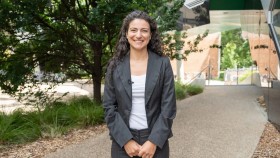A koala’s guide to the treetop buffet
The way that koalas in the wild distinguish between thousands of types of potentially nauseating tree leaves when eating has been revealed by ANU researchers.
In the same way that humans learn to avoid foods that make us ill, koalas also learn from experience what to eat and what to avoid, according to research published by Dr Ben Moore and Professor Bill Foley from the School of Botany and Zoology at The Australian National University in Canberra in the latest edition of Nature.
“Fortunately for bushwalkers, the koalas’ learned association between nauseating toxins and the smell of certain leaves means they don’t become physically sick,” Dr Moore said.
The researchers mapped the content of nutrients and toxins in every tree in an area of forest on Victoria’s Phillip Island.
“Although we already knew that a particularly sickening group of toxins controls how much koalas eat in captivity, koalas in the wild have many more choices and have to contend with predators, changing weather and the need to keep in touch with each other,” Dr Moore explained.
“It’s like having to choose between 1000 restaurants (or trees in the koalas’ case), spread all over town, without a restaurant guide.”
By combining their map with data collected by the local Friends of the Koalas group over 10 years, the researchers found that koalas prefer larger trees — which provide more food and shelter and a greater chance of interaction with other koalas — over small ones.
“However, among these large trees, they avoid those that have leaves with an excess of nauseating toxins and trees with leaves that contain little protein,” Dr Moore said.
Dr Moore said the research should inform conservation of trees, based on whether they are an important food source for animals.
“Plant chemistry restricts the use of trees by koalas, and thus limits the food available to koalas and potentially influences koala populations,” he said.
“Our results show that what simply looks like a patch of forest to us can actually be a complicated mosaic of good and bad food patches for wildlife. Some trees can largely escape being eaten while some particular trees are especially important food resources.
“This reinforces the need to conserve large old trees for all wildlife, not just those species that use hollows for nesting.
“Large trees can take hundreds of years to grow and their loss through logging or just old age reduces both the amount of food available for leaf-eating animals, like the koala, and also limits their ability to choose the highest quality diet possible.”
Dr Moore undertook the research as part of his PhD at ANU in collaboration with Professor Foley. Dr Moore is currently a post-doctoral fellow at James Cook University.
Photo: A male koala on Phillip Island, by Dr Ben Moore.
This news story has been kept for historical purposes, and content may now be out of date
Related links
- Koalas peruse treetop buffet with care - ABC Science











